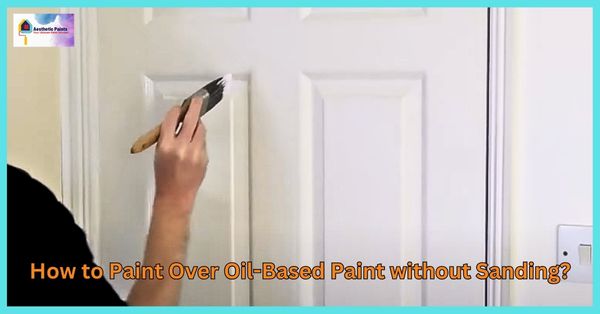What you need to do before taking a paint project is to have proper planning. These might include choosing the right colors, getting the required materials, and preparing the paint surface for a fresh coating. It will ensure you have the desired painted surface.
However, painting directly over an oil-based paint without sanding might not give you the best results. So, how to paint over oil-based paint without sanding?
Simply start by applying a primer to the surface and allow it to sit for some time. Next, apply the paint over the surface. Continue reading the post to learn more about how to complete the task fast with less effort.
Can you apply latex to the oil paint surface directly?
Yes, you can but you may not get the desired result as expected. So, it is not a good idea to apply a fresh coat of paint over an oil-based paint surface. And, there is a good reason why you need to prepare the surface first to make the process simple.
Preparing the surface first for the fresh paint is a necessity. Or else, the paint won’t stick properly. As a result, it will peel off in no time if the paint is water-based. However, you can apply oil-based paint to latex paint conveniently.
Now that you are aware of why it might not be a good idea to apply paint over oil-based paint, let’s know how to complete the task in the best possible way.
Supplies you will need for painting over oil-based paint without sanding?
Below listed are the tools and supplies that you need for the purpose.
- A putty knife
- A paint roller or a paintbrush
- 150-grit sandpaper
- A piece of clean cloth
- Primer
- Latex paint
A quick-drying latex paint is recommended because it allows you to complete the work faster. Consider buying an extreme-bonding primer to make sure it sticks the right way. Using a regular primer may get you inconsistent results sometimes.
Now, let’s move on with how to paint over the oil-based surface effectively.

5 step-by-step guide to paint over the oil-based paint surface
Follow these steps to achieve satisfying results.
Step 1: Start by removing the old paint
You have to remove the water-based paint over the oil paint. Failing to do so will result in the paint giving off after some time. Hence, you should remove it and prepare the surface for the new coat of paint.
To peel the old paint away, use a putty knife. When you use the knife, the paint should come off easily without applying much force. Consider removing as much peeling paint as possible before heading over to the next step.
Step 2: Prepare the surface
After peeling off the old paint, it’s time for sanding. Keep in mind that you don’t have to use sandpaper always. Most primers will stick over an oil-based surface. You may skip this step but it is highly recommended to sand the surface before applying the primer.
It will make sure that the primer adheres to the surface. Use 150-grit sandpaper to make the oil paint surface clean. Remember that you don’t have to remove the paint by sanding. It will be enough to make the surface rough. As such, the primer would adhere to the surface the right way.
Step 3: Make the surface clean
This is an important step that you shouldn’t ignore even if it feels right to skip sanding. Clean the surface so that the paint adheres to the surface effortlessly. Besides, this step is quite easy. Use some water and a clean piece of cloth to remove dirt and dust from the surface.
Step 4: Applying the paint primer
It is time for you to apply the chosen primer on the rough surface. Primers work like normal paint when painted on surfaces. But they will adhere perfectly to most surfaces and make the surface eligible for fresh paint.
Use a paint roller or a paintbrush when using the primer. Make sure that you apply thin coats of primer several times. Allow the primer to dry for some time in between applications.
Typically, it takes about two to three coats for the primer to cover the old coat completely. Moreover, you can use sandpaper to make the surface smoother if the results don’t satisfy you.
Step 5: Applying the fresh coat of paint
Finally, the surface is ready to be painted with a fresh coat. Apply the paint in several thin coats by using a paintbrush or paint roller. Allow the paint to dry for some time between coats.
Although it depends on the kind of paint you are using, most paints take about two to four coats to complete.
How do you paint over an oil-based paint without using sandpaper?
Sanding any kind of surface takes an adequate amount of time and doing the same before applying the primer is no different. Many people would want to know if they can paint over an oil-based paint surface without using sandpaper first.
Yes, you don’t have to use sandpaper before painting over an oil-based surface. However, make sure that you are using a high-bonding primer. Additionally, the surface has to be clean and intact. Apply the primer and allow it to sit for some time until it dries. You can use paint on the surface.
Use this method if the old paint is intact and there are no signs of peeling. But you should sand the surface so that the primer adheres to it efficiently. There is little chance that even a high-bond primer may not bind with the oil paint conveniently.
WRAP UP
Because sanding takes a considerable amount of time, many people wonder if they can paint over the oil-based surface without sanding. In this situation, you can apply a primer with high-bonding capability on the surface and allow it to dry.
After that, you can apply the new paint on the surface. Still, it is wise to sand the surface first to make sure that the primer adheres properly. In rare cases, even a high-bonding primer can face difficulties when binding to oil paint surfaces.






